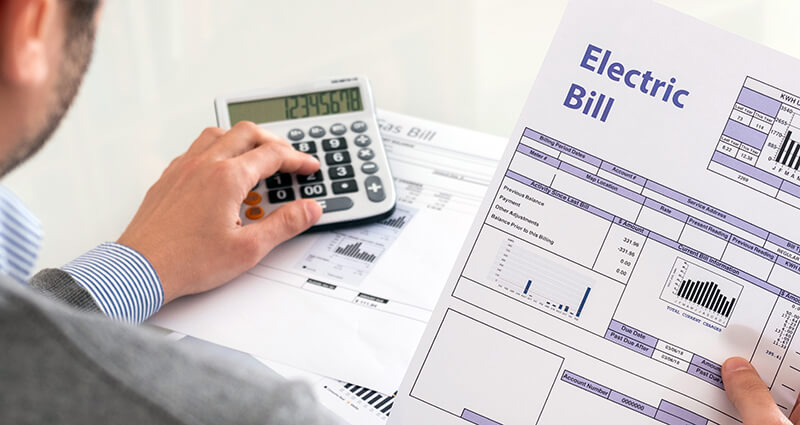Your electricity bill is too high. You pay too much money every month. You need to know exactly which devices are stealing your cash.
To calculate your monthly usage, you need three things: device wattage, daily hours of use, and days per month. You multiply these numbers, then divide by 1,000 to get monthly kilowatt-hours (kWh).
Let me show you the simple math I use.
[Table of contents]
How do I calculate the power consumption in my own home or office?
You need a solid starting point for your calculations. Forget the complex formulas for a moment. We will break down how to get the most important numbers first.
Calculating power consumption at home starts by finding the wattage (W) of each appliance. The power consumption is the rate at which your devices use electricity over time. We measure it in Watts.
When people ask me about energy, I always tell them to start with Watts. Watts are the ‘speed’ your device eats power. Knowing this is the first step to saving money, whether you use solar or grid power.
Where can I find the wattage of a device?
You don’t need to be an engineer to find this number. I learned this years ago when I was a production manager. It’s usually printed clearly somewhere.
- Look at the label: Most appliances have a label on the back or bottom. Look for “W,” “Watts,” or “Power Input.”
- Check the manual: The user manual always lists the technical specifications.
- Use a Wattmeter: If you want perfect accuracy, buy a simple plug-in Wattmeter. They are cheap and show you real-time use. This is the best way to catch those “vampire” devices.
What are the real costs of ‘Standby Power’?
Many buyers focus only on a device’s running power. That’s a mistake. Standby power—the power used when the device is “off” but still plugged in—can add up.
| Device Type | Average Standby Power (W) | Notes |
|---|---|---|
| TV | $0.5 – 3.0$ W | Newer models are usually better. |
| Phone Charger | $0.1 – 0.5$ W | Small, but it is 24/7 power use. |
| Desktop PC | $2.0 – 5.0$ W | Can be high if not fully shut down. |
I tell all my clients: A high-quality solar system needs to account for this 24/7 background load.
How do I calculate the daily watt-hours and convert them to kilowatts per month?
Now that you have the Wattage, it is time to move on to the time factor. You must track how long you actually use the device each day.
To find your daily watt-hours (Wh), you multiply the device’s Wattage (W) by the daily usage time (Hours). We use this number to get to the monthly cost.

This is where people often get lazy with their estimates. I see it all the time with businesses: they guess the usage. Guessing costs you money.
Step 1: Calculate Daily Watt-Hours (Wh)
The formula is very simple.
To calculate your energy consumption, multiply an appliance’s wattage by the number of hours you use it in a day (the watt-hours).
Device Wattage (watts) X Hours Used Per Day = Watt-hours (Wh) per day
Example: A 170-watt television used three hours per day
170 watts X 3 hours = 510 Wh/Day
Step 2: Converting Watt-Hours to Kilowatt-Hours (kWh)
Your electricity bill is measured in kilowatt-hours (kWh), not watt-hours. One kilowatt is equal to 1,000 watts. To calculate how many kWh a device uses, divide the watt-hours from the previous step by 1,000.
Device Usage (Wh) / 1,000 (Wh/kWh) = Device Usage in kWh
Example: A television using 510 Wh of electricity per day
510 / 1,000 = 0.51
This conversion is critical for figuring out your bill.
What is the simple process to find my total monthly energy usage (kWh)?
You have the daily number in kWh. The final step is to stretch that usage across a whole month. This gives you the total energy you actually pay for.
To find the monthly kWh, you take your daily kWh usage and multiply it by the number of days in the month (usually 30). This total kWh is what determines your bill cost.
When I was starting XRSOLAR, I had to be precise with material costs. This is the same idea. Precision matters for your electricity bill, too.
How to Calculate kWh Per Month for One Device
We need the full monthly total.
Now that we know how many kWh the appliance uses per day, we can estimate that usage over the course of a month. Multiply the daily usage by 30 days to calculate the approximate monthly kWh usage.
Daily Usage (kWh) X 30 (Days) = Approximate Monthly Usage (kWh/Month)
Example: A television using 0.51 kWh of electricity per day
0.51 kWh X 30 Days = 15.3 kWh/Month
In this example, a 170-watt television you use for three hours every day accounts for 15.3 kWh of energy per month. This is the television’s monthly energy consumption.
How much do appliances cost on my electricity bill?
Now we talk money. You need your local utility rate. My friends in Thailand tell me the rates can change, so always check your latest bill.
To estimate how much an appliance adds to your electricity bill, check your latest bill to find the price you pay per kWh, otherwise known as your electric rate. To determine how much your appliances cost per month, multiply your electric rate by the estimated monthly usage from the previous step.
Monthly Usage (kWh) X Electric Rate ($/kWh) = Approximate Cost per Month
Example: A television using 15.3 kWh/Month with an electric rate of 16 cents per kWh ($0.16/kWh)
15.3 kWh X $0.16 = $2.44/Monthly Bill
This television would cost $2.44 per monthly energy bill based on these calculations. While that might not seem like much, the appliances and devices in your home can add up quickly.
Remember, your appliances and devices only account for part of your energy bill. Your bill also includes heating, cooling, and lighting, which add to your costs. If your home has a smart meter, you can track your usage and multiply the kWh for that month by your electric rate (like we did in the most recent step) to get a more accurate bill estimate.
How do seasonal energy trends and good habits affect my power consumption?
The math is done. But electricity usage is not just math. Your habits and the weather change things a lot. We need to talk about real-world use.
Seasonal trends are a major factor; air conditioners and heaters will spike your usage in summer and winter. Small changes in daily habits, like unplugging devices, can significantly cut down overall consumption.
You are a business owner and buyer, so you know about supply chains and logistics. Energy is the same: when demand is high, the cost and use go up.
Key Energy Consumption Tips for Buyers
You are looking for quality and competitive prices. Use these tips to reduce your need for power, making your overall system investment smaller and more efficient.
- Look for Energy Star: When you buy new equipment, always check for the Energy Star label. It is a simple way to confirm the device is energy-efficient.
- Unplug Vampire Devices: Get into the habit of unplugging non-essential devices when not in use. Or, use power strips with on/off switches.
- Optimize AC Use: The air conditioner is usually the biggest cost. Set it a few degrees higher. Use timers. Every degree cooler costs you money.
Why Your Estimation Needs a “Buffer”
When you calculate your needs, always add a 20% buffer. Shipments get delayed. Weather changes suddenly. You must be prepared.
When XRSOLAR designs a system, we add a buffer to ensure you never miss your selling season due to a lack of power. This simple rule keeps your business running smoothly.
Conclusion
The summary for the whole post.
Knowing your exact Wattage, usage hours, and the kWh conversion is key. This simple math helps you manage your costs and correctly size any future solar system.





0 Comments